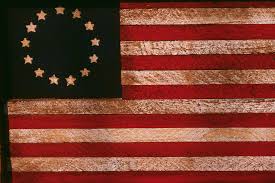| 4th Middlesex County Militia Regiment | |
|---|---|
 | |
| Active | 1777–1780 |
| Country | United States of America |
| Allegiance | Continental Army |
| Type | Infantry |
| Engagements | wikipedia:Saratoga Campaign Wikipedia:Battle of White Plains |
| Commanders | |
| Notable commanders |
Colonel Ezekiel Howe Col. Cyprian Howe (1726-1790) |
For more information see Massachusetts Colonial Militia in the Revolutionary War.
Unit History[]
Background[]
On January 22, 1776, the Provincial Congress of Massachusetts passed a statute reorganizing that colony's militia, replacing the loosely-structured volunteer army of 1774-5 with a more permanent and formal organization.
The new militia regiments were organized into county-wide brigades and included all able-bodied male citizens between 16 and 60. In addition to providing local defense and training these regiments served as the primary source of reinforcements for the Continental Army throughout the war.
Middlesex County, Massachusetts was organized into seven regiments under the command of Brigadier General Oliver Prescott of Groton.
After the Revolution the Regiment continued to serve for many years as part of the active Massachusetts militia.
4th Regiment Organized[]
The Fourth Middlesex Regiment embraced the towns of Sudbury, Marlborough, and Stow, and included nearly 1,000 men on its rolls. Colonel Ezekiel Howe of Sudbury was appointed commanding officer of the nine-company regiment, serving until 1779 when he was succeeded by Col. Cyprian Howe of Marlboro.
A majority of the men in the Fourth Middlesex were veterans of the fighting at Concord and Lexington (see Marlborough 1775 Minuteman Roster), and a great many had also served at Bunker Hill or during the siege of Boston in 1775-6.
Fort Ticonderoga[]
In July of 1776 a severe threat to New England posed by General Carleton's army advancing from Canada resulted in the mobilization of well over 100 men from the Fourth Middlesex Regiment. Under the command of Captain Asahel Wheeler of Sudbury they served for five months at Fort Ticonderoga in General Brickett's brigade of Massachusetts militia. During this time they reconstructed the old French redoubts along the lake shore, completing the job in time to form a vital link in the Ticonderoga defenses which stopped Carleton's army and forced its return to Canada following General Arnold's defeat at Valcour Island.
Battle of White Plains[]
In September 1776, another draft of Fourth Middlesex Regiment men sent them southward in response to the critical position of the Continental Army at New York. They marched under command of Captain Amasa Cranson of Marlboro, in Major General Lincoln's division, and were active in the early fighting around White Plains.
New York City[]
The following January a Fourth Middlesex company under Captain Nathaniel Maynard of Sudbury served for two months in the New York City area in Colonel Samuel Thatcher's regiment. The militia at that time was active in continual skirmishes with British and Hessian foraging parties and other detachments supporting Howe's army as it wintered in New York.
Return to Ticonderoga[]
An urgent appeal for help following the capture of Fort Ticonderoga by the British in July 1777 resulted in a large turnout of men from the Fourth Middlesex Regiment. Two companies, commanded by Captains Jonathan Rice and Caleb Moulton of Sudbury, departed on August 20 "to reinforce the Continental army at the Northward". They were assigned to Colonel Samuel Bullard's regiment, Brig. General Jonathan Warner's brigade, and were part of the army that finally defeated Burgoyne at Saratoga, although Warner's brigade was not directly engaged during the two major battles. The brigade was, however, present at the surrender on October 17th. Three additional companies from the Fourth Middlesex left for Saratoga about October lst, reached Stillwater, but did not participate in the surrender.
Rhode Island Deployments[]
In January 1778, a full company under Captain Benjamin Munroe of Stow was detached from the Fourth Middlesex to serve for three months in Rhode Island as part of Colonel Sprout's regiment. Later, in July of that year, a joint American-French campaign was formed to drive the British army from Newport and a call for militia brought 7,000 men, including a Fourth Middlesex company under Captain Robert Cutting of Sudbury. Cutting's company fought under General Sullivan and shared in the controversial American defeat during the Battle of Rhode Island.
As the war moved south after 1778, detachments of company size and smaller from the Fourth Middlesex Regiment were engaged at Claverack, Fort Clinton, Peekskill, and other defensive posts along the Hudson, as well as in Rhode Island, thus relieving Continental units for duty with Washington's main army in the southern states.
Unit Rosters[]
Command Staff: Officers[]
- Col. Cyprian Howe - from Marlborough, as Captain he served under Colonel Henry Gardiner in the 4th regiment,Middlesex Co.at the opening of the Revolution and marched to Cambridge on the Lexington Alarm on the 19th of April 1775 . He was promoted to Lieutenant-Colonel in 1776 and Colonel (Commanding officer of the 4th Middlesex) in 1779.
5th Company: Capt Moses Barnes[]
- Bigelow, Ivory, Lt (1741-1804) - list of men in service between 1778 and 1779; also, 2d Lieutenant, Capt. Moses Barnes's (5th) co., 4th Middlesex regt.;
References[]
- Saintonge - Units of the Revolutionary War